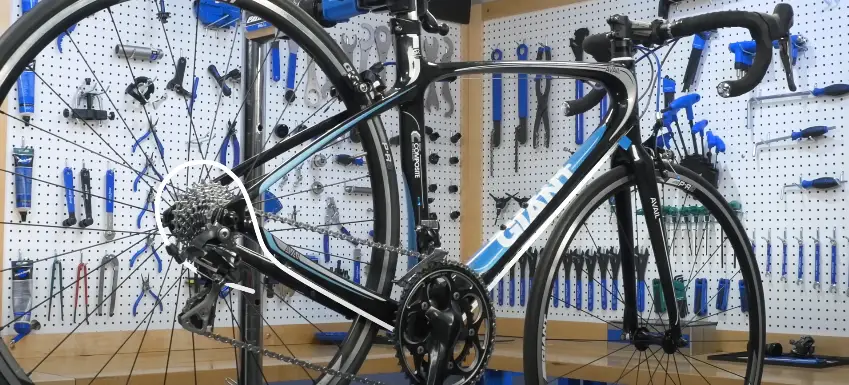MTB derailleurs are a set of crucial components that ensure smooth gear shifting on your mountain bike, allowing you to ride with comfort across varying terrain. Derailleurs move the chain among the gears on the cassette or chainring so you can select the appropriate gear for the situation at hand. However, eventually, derailleurs will require adjustments so they continue to shift smoothly and efficiently.
Knowing how to adjust MTB derailleurs is crucial for every cyclist who wants their bike to be in top condition. Well-adjusted derailleurs can prevent issues like skipped gears or sloppy shifting, improving your cycling experience.
2. What Is a Derailleur and How Does It Work?
A device called a derailleur shifts the chain between the cassette’s gearsor chainring to help you get the right gear for your riding conditions. It is crucial to make smooth transitions while shifting gears, and you can shift up or down without ending your ride. The derailleur moves the chain over the cogs by pushing or pulling and maintaining tension to fit the selected gear.
There are generally two types of derailleurs on a mountain bike: front and rear. The rear derailleur controls the shifting on the rear cassette, and the front derailleur handles chainring shifts. Together, they give a fantastic amount of gears to handle varying terrain, from sharp climbs to fast descents.
3. When Should You Adjust Your MTB Derailleur?
It’s important to know how to adjust your MTB derailleur in order to keep riding smooth and responsive, since derailleur problems can hinder gear shifting performance. The following are some indications that your derailleur needs adjustment:
- Slipping or skipping gears: If your chain skips unexpectedly during riding, your derailleur may require realignment or adjustment.
- Terrible shifting action: If shifting is slow or jerky, tension or alignment likely needs to be adjusted.
- Chain rub or chatter: With continual rubbing or scraping sounds, the derailleur is likely out of alignment.
- Cross-chaining or derailing of the chain: If the chain derails or refuses to stay on certain gears, the derailleur might need a more thorough examination.
4. Tools You’ll Need to Adjust MTB Derailleurs
To successfully adjust your MTB derailleur, you’ll need a few essential tools, including a 5mm Allen wrench, a screwdriver, and possibly a chain tool. Here’s a breakdown of the tools you’ll need:
- 5mm Allen wrench: Used for adjusting the derailleur mounting bolts and sometimes the limit screws.
- Flathead and Phillips screwdrivers: Used to adjust the high and low limit screws or to move the derailleur position.
- Chain tool: If you ever need to remove or unmount the chain, a chain tool is essential.
- Barrel adjuster tool: Sometimes part of the bike itself, this tool is employed to adjust cable tension for smoother shifting.
- Derailleur hanger alignment tool (optional): Employed to ensure that the derailleur hanger is straight as a guideline.
Having these types of tools on hand will guarantee your derailleur adjustment will be efficient and effective.
5. Step-by-Step Procedure for MTB Derailleurs Adjustment
Step 1: Derailleur Alignment Check
Prior to making any adjustment, verify that the derailleur hanger is in line, since misalignment will cause shifting issues. The derailleur hanger, if deformed, will prevent the derailleur from shifting properly, resulting in ragged shifting or chain drop. You may verify alignment with a derailleur hanger alignment tool or visually against the bike frame. If deformed, you can use the tool to gently bend it into position or replace it if needed.
Step 2: Install the High and Low Limit Screws
The high and low limit screws prevent the derailleur from forcing the chain too far over the cassette. The high limit screw controls the derailleur’s movement toward the smallest cog, and the low limit screw controls its movement toward the biggest cog. Turning these screws clockwise or counterclockwise will set the range of motion for the derailleur so that it will shift correctly without sending the chain off the cassette.
Step 3: Micro-Adjust the Barrel Adjuster
Use the barrel adjuster to make small adjustments to the derailleur tension, offering ideal shifting performance. Rotating the barrel adjuster clockwise tightens the cable and makes the shifts harder by tightening it.
Rotating it the other way loosens tension, causing the derailleur to shift easier. Micro-adjusting the barrel adjuster smooths the shifts, especially when the derailleur is slightly out of adjustment following initial adjustments.
Step 4: Check and Control Chain Tension
Chain tension must be proper for optimal shifting, so make it not too tight or too loose to provide best derailleur movement. Check the tension while pedaling and observing the chain in an intermediate gear. If too loose or too tight, the chain or derailleur will have to be adjusted or lengthened. A chain that is too tight will hinder smooth shifting, while a chain that is too loose may cause slippage.
Step 5: Test Shifting Performance
After adjustments have been made, test shifting through a range of gears and loaded to have smooth, accurate movements. Shift through the entire range of gears under riding conditions or on a stationary trainer, observing for smoothness. If you experience skipping or hesitation, return to the high and low limit screws or adjust the barrel adjuster again.
6. Troubleshooting Common MTB Derailleur Issues
Even with fine-tuning, you may encounter issues such as chain skipping or mis-shifting—following tips below on how to troubleshoot these problems:
- Skipping gears: If the chain skips when under load, the derailleur might not be properly aligned or the limit screws need some fine-tuning again.
- Chain rubbing on derailleur cage: This could be caused by incorrect derailleur alignment or worn chain. Check the alignment and replace the chain if worn out.
- Slow or draggy shifting: The cables are perhaps low. Try adjusting the barrel adjuster to achieve more positive shifting.
- Chain falling off: If the chain falls off the largest or smallest cog, check the limit screws and tighten them to prevent the derailleur from overshooting.
- Cable stretch: Cables will stretch out over time and become loose. When the shifting becomes slow, reset the barrel adjuster or replace cables.
7. Preventative Maintenance of MTB Derailleurs
Regular maintenance is critical to lengthen the lifespan of your MTB derailleur and to provide uninterrupted shifting during riding. The following are some guidelines that can help you:
- Cleaning the derailleur regularly: The shifting capability of the derailleur can be affected by grime and dirt, so cleaning the cassette and the derailleur after every ride on wet or dirty terrain is recommended.
- Lubricate the chain: Lubrication of the chain reduces friction, improving shifting quality and the life of the derailleur and chain.
- Inspect the derailleur hanger: Inspect the derailleur hanger regularly for correct alignment to prevent shifting and also from damaging it.
- Check cable tension: Cable tension should be checked from time to time and adjusted if necessary to provide smooth and quick shifting.
- Replace worn components: If derailleur, cassette, or chain are worn out, replace them in order to avoid poor performance and extra damage to the bike.
FAQ’s
Q1: How can I be certain that my MTB derailleur requires adjustment?
- If you find difficulties such as skipping gears, poor shifting, or chain drop, then it is likely you need to adjust your derailleur.
Q2: Why won’t my bike chain shift following derailleur adjustment?
- Poorly adjusted high/low limit screws, improper derailleur hanger alignment, or improper chain tension are the potential causes of poor shifting performance.
Q3: Can I make changes to my MTB derailleur without specialist tools?
- Certain minor changes like barrel adjuster setting are achievable without specialist tools, but more sensitive procedures (e.g., aligning the derailleur or limit screw setting) will have to be done using several basic tools.
Q4: How often should I be making changes to my MTB derailleur?
- You need to be checking and adjusting your derailleur regularly, especially after any large ride, crash, or after riding in extreme conditions like mud or rain.
Q5: Is adjusting the derailleur a pain?
- With the proper tools and a bit of patience, it’s a simple adjustment to do for most riders even if you’re not very good at fixing bikes.
Q6: My derailleur shifts slowly. What can I check?
- Shifting slowly may be due to chain wear, misaligned derailleur, or incorrect cable tension. Check and adjust each accordingly.
Conclusion
Shifting your MTB derailleur is easy, it just requires patience and the proper tools—regular adjustments ensure your bike is always ready for your next ride. By re-checking the alignment, tightening and loosening tension, and ensuring gears change smoothly, you’ll keep your derailleur in top shape to perform optimally. Through maintenance, not just will you have a smoother ride but also extend the life of the bike components.
Having the right knowledge, you will be able to deal with any derailleur problem and have your mountain bike shift like new.

I am Ryan Ford, a mountain biking enthusiast who loves to explore the outdoors. I also like to go on adventures with friends and anything else that involves being outside. I love my bike because it gets me out of the house and gives me an opportunity to enjoy nature.

